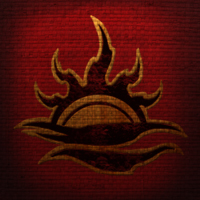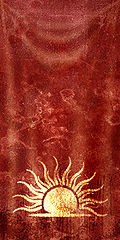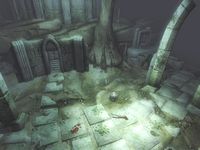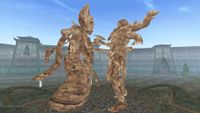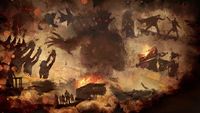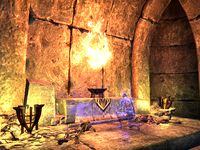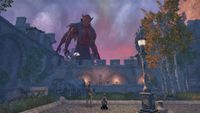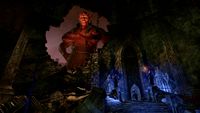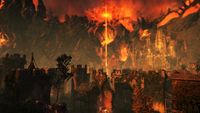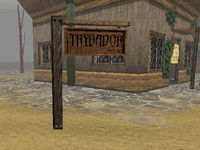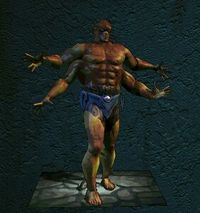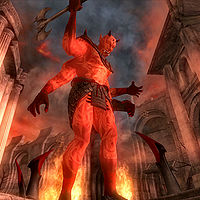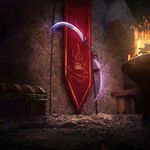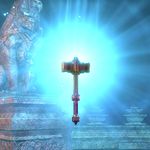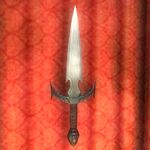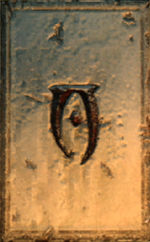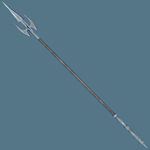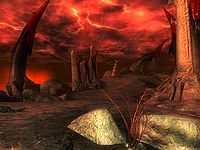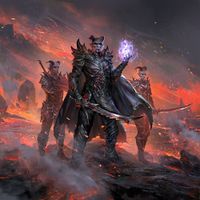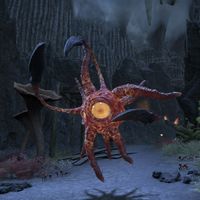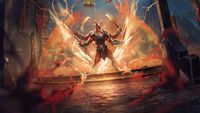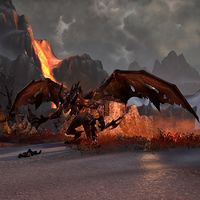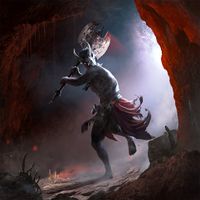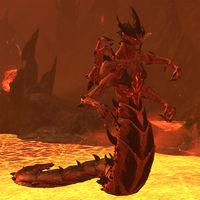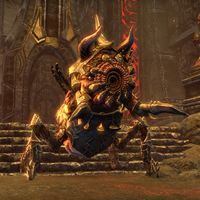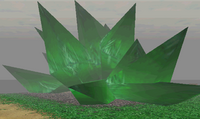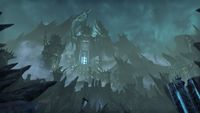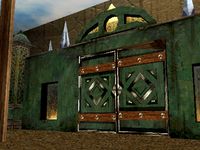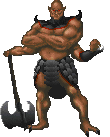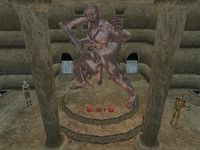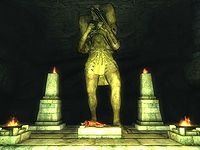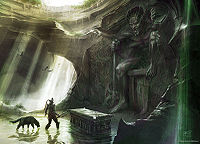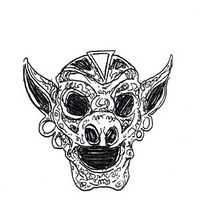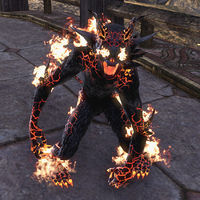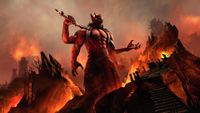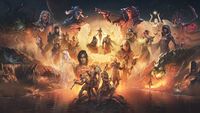Lore:Mehrunes Dagon
Mehrunes Dagon (formally, the Exalted and Most Puissant Lord, Gerent of Dagon, Mehrunes),[1] also called the Black Daedra Lord,[2] Prince of Ambition,[3] Prince of Disaster and Destruction,[4] Master of Razors,[5] Sovereign of Destruction, the Flame Tyrant, the Father of Cataclysm,[6] the Golden Flame,[7][8] the Flame-Father,[9], the Prince of Being Defeated[10], and the Mer-Pride's End,[4] is the Daedric Prince of Darkness and Destruction,[11]:18 whose sphere encompasses destruction, change, revolution, energy, and ambition.[12] The Lord of Fire and Flood[4] is associated with natural dangers like fires or earthquakes.[13] Flash floods, thunderstorms, and other natural disasters have been linked to communions between him and his cultists.[5] The Prince is also said to be the author of the Mysterium Xarxes.[14][15] Mehrunes Dagon has an insatiable hunger for destruction.[16]
Xivilai Moath and Faydra Shardai are Dagon's adoptive children.[11]:156,159 There is a belief that Mehrunes Dagon is allied with Hircine,[nb 1] though Lyranth the Foolkiller claims that if such an arrangement exists, it would be obscure outside their own circle.[17] Enemies of the Prince of Destruction include Ebonarm,[18] Akatosh,[19] and Molag Bal, with whom Dagon shares a bitter rivalry—the two have been known to meddle in each other's schemes when the opportunity arises.[16] It is also rumored that the Prince hates Nocturnal.[20] Dagon's protonymic is Lehkelogah[21][22] and his neonymic is Djehkeleho-dehbe-effehezepeh.[23] The Prince's summoning day coincides with the Warriors Festival, the 20th of Sun's Dusk.[24]
Mythology[edit]
The Mysterium Xarxes[edit]
—— Mehrunes Dagon, Mysterium Xarxes [14][25]
Little is known of the contents of the Mysterium Xarxes outside of the alleged translations given in Mankar Camoran's Commentaries on the Mysterium Xarxes.[14][26] While the Commentaries were known to be used in the Third Era to surreptitiously recruit members into Dagon's cult, the Mythic Dawn,[27] they also contain a peculiar account of the Prince's origins.[26]
According to the Commentaries, the Magna Ge secretly created Mehrunes Dagon in "the very bowels of Lyg".[28] Lyg, it is claimed, is an "Adjacent Place", a sort of parallel version of Tamriel,[UOL 1] and the domain of a deity known as "the Upstart who vanishes".[28] Lyg, the "Mundex Terrene", was once ruled by dreugh-kings from the "nineteen and nine and nine" seas, who waged endless wars against each other's "slave oceans".
Dagon was created to be a prince of good, and was imbued with Oblivion's most precious asset, hope. The Prince began a revolution, "threw down Lyg", and "cracked his face".[28] He let the lowly slaves know free will, and stirred them to violence against their masters.[29] His "red legion" overthrew the tyrant dreughs, toppled the towers of CHIM-EL GHARJYG, destroyed great cities, and slaughtered the templars of the Upstart. Hope spread like a "brush-fire" as the world was set Free.[28] Hence his title of the Sea's Flame Redeemer.[4]
Regardless of the veracity of this account, the tome played a role in the assassination of Uriel Septim VII and his heirs, starting the Oblivion Crisis.[28][30]
A story from obscure Nordic myth provides an alternative origin of the Daedric Prince, claiming him to have once been a kinder being who was cursed by Alduin.[UOL 2]
Worship and Culture[edit]
Worshippers of the Prince of Destruction are known as Dagonites[31] and Dagonists.[32]
He is revered by many groups Daedra, such as the Crimson Oath, who know the Great Prince by many names and call themselves the oathsworn of the Red Father, scarlet reavers of the Razor King, and bloodletters of the Fire-Veined God.[33]
In most cultures, Mehrunes Dagon is little more than a god of bloodshed and betrayal.[34] Dagon revels in destruction on a grand scale, from mass murder to deaths resulting from floods or earthquakes. He leaves a swath of devastation whenever he manifests. In fact, even attempting to summon the Prince is frequently fatal for the conjurer and any bystanders. Trafficking with Dagon or his cultists is abhorred by most of Tamriel, and is outright illegal in many places, where the punishment can be as severe as death.[16][35][5].
He has a vested interest in showing flagrant displays of power to attract followers to his various cults and assert his influence on Nirn.[35] He is an especially important deity in Morrowind, where he is the Second of the Four Corners of the House of Troubles.[36][37] Worshippers of Dagon tend to be arsonists, setting buildings, animals, and even people on fire. Signs of cultist activity include unusual tremors, an uncharacteristic lack of rain and sudden onsets of unseasonably heavy rain as they attempt to incite natural disasters. Those who worship the Prince tend to bear the symbol of a fiery, rising sun.[35] Dagon's cults have a tendency to plan deep and long-burgeoning conspiracies.[16]
Argonians[edit]
The Sul-Xan Tribe consist of naga worshippers of chaos and death, and see Mehrunes Dagon as the True Egg-Child of Sithis.[UOL 3] This title can be understood from a pre-Duskfall perspective, when the old ruling class of Black Marsh believed that Sithis was a malevolent destructive force,[38] much like Dagon. The Sul-Xan embrace only "the darkest, cruelest beliefs, and scorn the rest as weakness."[39] Thus, they sacrifice outsiders and other Argonians alike in hopes of one day summoning Mehrunes Dagon to bring blood and destruction across Black Marsh,[40] and eventually the entire world.[41]
The Sul-Xan's worship of the Razor Prince[42] is an anomaly, as Argonian society at large does not partake in the veneration of powers from Oblivion. In fact, there are no words in their language Jel to describe any of the Daedra. As explained by a native speaker during the Interregnum, the Argonians do not "taint their language with words for abominations from Oblivion". Instead, they use common words from other more widely-spoken languages to refer to the beasts.[43]
Dunmer[edit]
In Morrowind, Mehrunes Dagon is the God of Destruction[44] the Horror,[45] the Destroyer-God,[46] the Dark One,[UOL 4] Lord of Blood and Flame,[47] Oblivion's Favored Son, Calamity's Tyrant King,[48] and the King of Blood[UOL 5] (contrasting his title of the Hope of Blood).[4] It is said that when the prophet Veloth led the Chimer to Resdayn (now Morrowind), they were joined by a number of Daedric ancestral spirits, among them Mehrunes Dagon.[36] At first, these Daedra Lords were worshipped as gods.[49] However, when the Tribunal came to power in the early First Era, Daedra were venerated as lesser spirits, subservient to the Almsivi.[50]
Not content with this power shift, Malacath, Molag Bal, Sheogorath, and Dagon rebelled against the new Temple, which caused much strife among the Great Houses.[36] These Rebel Daedra, or Bad Daedra,[50] became the Four Corners of the House of Troubles, who tempt the Dunmer away from the orthodoxy.[49] Nevertheless, the Dunmer consider these four to be holy in that they serve as Testing Gods who must be appeased.[36][44] Dagon represents Morrowind's near-inhospitable terrain,[44] and also tests the Dunmeri will to live and prosper.[36]
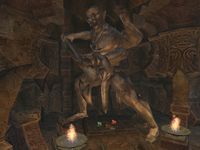
According to legend, Mehrunes Dagon once threatened to heave a large rock at the Dunmer of Maar Gan. Vivec outwitted the Prince, taunting Dagon and making himself the rock's target. The rock itself was enshrined there, becoming known as the "Magic Rock of Maar Gan", and it became a pilgrimage site. Pilgrims would have to re-create the situation during a pilgrimage. A Dremora named Anhaedra was bound by Vivec to fill Dagon's role, and would have to endure taunts from pilgrims and try to harm them while they were protected by a powerful blessing.[51]
Another legend involves a duel between Vivec and the Prince of Destruction, the latter of whom was unarmed. Rather than dishonoring himself by fighting an unarmed opponent, Vivec offered Dagon his own silver longsword. The Prince's Dremora were impressed by this honorable act of chivalry. The Temple claims that although they are enemies, the Dremora share a bond of respect and courtesy with the followers of the Tribunal. As part of the Pilgrimages of the Seven Graces, pilgrims seeking to join the Tribunal Temple must visit the Shrine of Courtesy in Vivec City's Puzzle Canal. A Dremora named Krazzt was bound here. Filling the role of Vivec, the pilgrim must be courteous and offer a silver longsword to Krazzt, who represents Mehrunes Dagon.[52][53]
Khajiit[edit]
In the Khajiiti pantheon, Mehrunes Dagon is Merrunz,[54] (also spelled Mehrunnez)[55] who is also called Daegon,[56][57] the Fire-Cat,[58] and the Demon Cat.[57] One of the children of Fadomai's second litter, Merrunz was given the nickname Ja'Khajiit—"kitten" in Ta'agra—by his mother due to his wild, destructive nature.[59][57] Similarly, the Khajiit often depict Merrunz as a "destructive kitten".[54]
According to pre-ri'Datta texts, at some point in time, Merrunz was exiled by his father, Ahnurr. Rather than journeying through the Many Paths of Time, Merrunz chose to venture into the Great Darkness. There, he was defeated by the Demon King Molagh and tortured until the world was created. Ultimately, Merrunz was freed by Molagh's wife, who used his destructive nature to attack the Lunar Lattice. Merrunz enjoyed this and became a "kinslayer", and has since been known as the demon Dagon.[59][57]
The duality of Khajiiti worship of the Fire-Cat can be seen early in Elsweyr's history. During Darloc Brae's reign, cultists of Merrunz burned down the Grand Archive in Corinthe, which contained the province's records from the Merethic Era. However, despite his worship of the Prince of Destruction, the warlord went through great lengths to preserve the remaining texts and hide them across Elsweyr, placing them in smaller vaults and archives.[60] Darloc Brae showcased an ambition much like Merrunz, conquering Anequina and the surrounding territories, with some areas erected in Daegon's name.[61]
Reachmen[edit]
To the Reachfolk, Mehrunes Dagon is the spirit of ambition and destruction, and is known as the Lord of Ambition. Life in the Reach is harsh, and its inhabitants always strive to improve. This drive to become greater eventually leads some to turn to Mehrunes Dagon.[62]
Order of the Waking Flame[edit]
The Order of the Waking Flame embraced Sister Celdina's beliefs that Mehrunes Dagon was created by the Magna Ge to unmake the flawed creation of Mundus in accordance to Magnus's plans.[63] To them, Mundus is a place of pain and suffering, thus they looked to Dagon to move past their mortal perils, hoping that he would purge the impurities of existence so that it may emerge anew.[64][65] This contrasted the ideas of Lyranth, who believes that when the Magna Ge fled, they spat on the conviction of the Aedra that remained to finish creating Mundus, and Dagon's emergence and sphere may be reflective of the destruction caused by their abandonment.[17]
The cult's High Chronicler documented epics involving Mehrunes Dagon. One teaches that Dagon does not back away from bargains. Summoned by the Enchanter Arebath for his dominion over fire and flood, the clash between Dagon's flames and Arabeth's tidal spell purged the local blighted wildlife, ensuring that lush flora would rise from the ashes.[64] Another story tells of the Prince invading Coldharbour to rescue the enslaved souls of his followers from Molag Bal. The true believers that refused to bend instead took it upon themselves to engage in subterfuge, thwarting Molag Bal and his minions whenever they could. Mehrunes Dagon rewarded those that endured with the means of their escape; a powerful explosion that rattled Coldharbour. The destruction allowed Dagon to manifest within the realm, where he engaged in combat with Molag Bal. Though Dagon's mere avatar was not able to defeat Molag Bal in his full power, this distraction bought enough time for his followers to escape into the Deadlands.[66]
The Mythic Dawn[edit]
The Mythic Dawn was once one of the most secretive and mysterious of Daedric cults[67] before gaining infamy due to its role in the Oblivion Crisis.[30] The cult's beliefs were largely shaped by the teachings of its leader, Mankar Camoran, and his Commentaries on the Mysterium Xarxes.[26][30][68] The name "Mythic Dawn" is a reference to the Dawn Era, the time before the creation of the world. Camoran believed he and his disciples were destined to rule over a reborn, "liberated" Tamriel, ushering in a new Dawn.[15]
Central to the cult's beliefs was the claim that the Divines are not gods, merely pretenders who have tricked mortals ever since they betrayed and attempted to destroy Lorkhan. The cult believes the Daedra are the true gods of the universe, as they cannot die. Camoran also asserted that Lorkhan is one of the Daedra, and offered this as to why the Heart of Lorkhan could not be destroyed. Furthermore, as a Daedric Prince, Lorkhan has his own plane of Oblivion—Tamriel.[nb 2] Thus, Mehrunes Dagon undertook the Oblivion Crisis not to destroy Tamriel, but to "liberate the Occupied Lands" from the Aedra.[69]
In Tamriel, the cult called their enemies the "Dragon's Blood"—a reference to the covenant between Akatosh and Queen Alessia which protected Nirn from the forces of Oblivion.[70] More prosaically, it refers to the line of rulers keeping the Dragonfires alight.[31] In particular, Mankar Camoran had a "long duel" with the Septim Dynasty,[69] dating back to the reign of Tiber Septim, when it is speculated the Commentaries were written.[67]
Mehrunes the Razor, Mehrunes the Thieftaker, Mehrunes Godsbody, and Mehrunes the Red Arms That Went Up are among some of the names given to the Prince of Destruction in the Mythic Dawn Commentaries.[28]
History[edit]
First Era[edit]
In ancient times, Dagon created a construct known as the Nefarivigum to challenge those who drew near to undertake a trial. One who passed the trial would be deemed worthy of wielding Mehrunes' Razor. Located in Cyrodiil, the Nefarivigum was discovered by the ancient Ayleids, who arrogantly believed they could turn away any who sought the Razor. To this end, they built the vast, ringed city of Varsa Baalim during the height of Ayleid civilization. For many years, pilgrims came to Varsa Baalim seeking the Razor, but the Ayleids turned them away. One day in the early years of the First Era, a vampire infiltrated the city. Before long, the city was infested with undead and thrust into chaos. The city suddenly and mysteriously disappeared. None know what happened, but Varsa Baalim seemingly vanished into the mountains of the Eastern Nibenay Basin.[71]
Mehrunes Dagon and his forces destroyed Ald Sotha, home of House Sotha, sometime in the early First Era. A young Sotha Sil was the only known survivor of this incident, having been rescued by Vivec.[72]
In response to the destruction of Gilverdale at the hands of Molag Bal, Sotha Sil, now a living god, sought out eight of the most influential Daedric Princes. Mehrunes Dagon was among them, and between the 3rd and 5th of Rain's Hand in 1E 2920, a deal was made which would become known as the Coldharbour Compact.[73] Little is known about the Compact, but it is theorized that it seeks to prevent the Princes from directly manifesting on Nirn,[74] and only permits them to commune with certain intermediaries, such as witches and sorcerers.[73]
Mehrunes Dagon's general attitude towards the Coldharbour Compact was that of indifference. To him, Sotha Sil was a mere mortal mechanist that was to be crushed like he did his childhood home, and no compact was to keep him from destroying Nirn.[4] This sentiment would manifest a few months later in Sun's Dusk of 1E 2920. The Skeffington Coven of High Rock took in an exiled Dunmeri woman named Turala, the former lover of the Duke of Mournhold, Brindisi Dorom.[75] However, after a trip to Wayrest, the Skeffington Coven was massacred by an Orcish raiding party. Turala was falsely led to believe that the massacre was the work of assassins sent by Brindisi Dorom himself. Enraged, the witch called forth the Prince of Destruction to destroy Mournhold and slay her former lover, and he complied.[76]
During the carnage, Almalexia and Sotha Sil arrived to stop the Prince. The battlefield was lit by a barrage of flame which fell indiscriminately. Almalexia plunged Hopesfire into Dagon's flesh and carved him from within. Meanwhile, Sotha Sil, enacting vengeance for Ald Sotha, used "god-bronze whips" to lash the Prince into submission. Wounded, Sil allegedly whispered Dagon's Nymic, and the Prince "exploded throughout all time".[77][78] Defeated, Dagon sought to have a final laugh, and flung a piece of Mournhold into his realm with the inhabitants intact.[79] After his banishment, Sotha Sil sealed the planar doors between Nirn and the Deadlands, blocking off all access for Dagon as further punishment for breaking the Coldharbour Compact.[80]
The Clockwork Apostles believe that this battle between Mehrunes Dagon and the Tribunal marked the birth of "Sarmissonays'um ghoul-thing[s]", which emerged from Dagon's own flayed skin.[6] Indeed, the Ruinachs, a four-armed race of Daedra, are thought by some scholars, mages, and even the Ruinachs themselves, to have emerged from Dagon's flesh in the wake of his battle against Almalexia.[81]
It is unknown what event prompted Dagon to begin working on a method to breach the Luminal Barriers. Some possibilities include (but are not limited to) when the Dragonfires were established by Saint Alessia,[82] or after Dagon was punished for breaking the Coldharbour Compact.[80] Regardless, Dagon began working on methods to bridge a path between his realm and Nirn to start his invasion, and so he began refining his dimension hopping technology.[83] The initial stages involved simple circular Oblivion Portals, but this would later develop into the framed doorways known as Oblivion Gates.[UOL 6]
Second Era[edit]
Emperor Durcorach allied with a Witchman coven, the Tagh Droiloch. With their help, Durcorach subdued all rival clans through means involving Daedric bargains. By 2E 528, he became warlord commanding two thousand soldiers, which rose to ten thousand by 2E 529.[84] A deal was struck with Mehrunes Dagon to have Durcorach crowned, with his sorcerers performing countless tasks in wait for the day when the "final part of the arrangement" would be carried out, and Dagon would "claim his due" with the Four Ambitions.[85]
After Emperorship was passed to him, Moricar "forged" the Ambitions, which were later entrusted to his son, Leovic. Although the bargain was intended to maintain the Longhouse Emperors' grip over Tamriel long after Durcorach's death, Leovic's decision to legalize Daedra worship led to a rebellion, which ended in Duke Varen Aquilarios slaying Leovic in the Imperial Throne Room.[86] Before his death, Leovic managed to hide the Four Ambitions across Tamriel, where they would be lost for a time.[87]
After the Soulburst[edit]
Mehrunes Dagon did not launch an invasion into Tamriel immediately after the Soulburst in 2E 579.[16] Circa 2E 582, displeased with the rise of the tolerant Queen Ayrenn and her (First) Aldmeri Dominion, High Kinlady Estre donned the role of the leader of the Altmeri separatists known as the Veiled Heritance. In her desperate attempt to impede the pass of Queen Ayrenn and her troops to Firsthold, she made a pact with Dagon. Estre summoned Daedra from the Deadlands in Dawnbreak's abandoned mine. The Daedra set the town alight and murdered its citizens until the First Auridon Marines intervened and organized an evacuation. The marines managed to stop the hordes from spreading across the area, and an Eye of the Queen came and defeated the Dremora that orchestrated the assault.[88]
Per her agreement with Mehrunes Dagon, High Kinlady Estre unleashed more Daedra upon Torinaan, a holy site of the Eight Divines in the north. She then moved on to her ultimate target, the city of Firsthold.[89] Here, she was let into the city by its ruler, High Kinlord Rilis XIII, who remained oblivious to her true nature. Once inside, she opened four Oblivion Gates across the city, allowing her Daedric army to lay siege to Firsthold and kidnap the kinlord. Estre was slain by a hero and the Oblivion Gates were closed, but most of Firsthold was left in ruins.[90]
Later that year, Dagon's Razor Master, Erthas, attacked the Bosmeri village of Whisper Grove. The forest was set ablaze, the village was overrun by Dagonites, and a portal to the Deadlands was opened to stir the chaos. The Undaunted were hired by the village's leader, Gilraen, to slay the Dagonites and push back the Daedra. After Erthas' death, Mehrunes Dagon himself offered to seal the portal if Gilraen agreed to meet with him in the Deadlands. Gilraen agreed, and the portal was shut.[91] Mehrunes Dagon gave Gilraen the means to survive in the Deadlands as a Razor Master, namely his eponymous Razor.[92]
Several months later, Gilraen's husband, Fingaenion, reopened the portal in a desperate bid to save his wife. He hired the Undaunted to enter Oblivion and retrieve her, but they failed.[93] Another group of Undaunted arrived hours later and successfully intervened. The adventurers went through the portal Fingaenion re-opened to enter the Knives of Discord, a region ruled by one of Mehrunes Dagon's lieutenants, Valkyn Skoria.[92] The Undaunted rescued Gilraen and their comrades, slew the Valkyn, and closed the portal.[94] Gilraen was worried that Mehrunes Dagon would seek her out, given that she facilitated the slaying of one of his lieutenants and fled the realm with his Razor.[92]
The Ambitions and Cataclysts[edit]
A chance encounter with the Bosmer Eveli Sharp-Arrow, and two further encounters with the Dremora Lyranth - subsequently led the Vestige an invitation to meet in a remote dungeon which revealed the existence of a secret involving the fallen Longhouse Emperors dynasty, a cult known as the Order of the Waking Flame, and a weapon associated with Mehrunes Dagon known as "The Four Ambitions". A list was found, of people who were apparently in on the secret - mostly but not all of them were members of Emperor Leovic's Elder Council, and some apparently knew part of the secret but none knew all: and one by one they were being murdered - apparently by the Dark Brotherhood.[95][96]
The Vestige worked with Eveli Sharp-Arrow to uncover the mystery, and warn the surviving councilors, many which were known to be in the Cyrodiilic region of Blackwood. Of them, most had reconciled themselves to the fall of the Longhouse Emperors, and managed to hang on to positions of regional importance - for instance, Councilor Tarnian Lovidicus had taken a place in the governing triumvirate of Leyawiin.[97] However, Councilor Ertus Vandacia still harbored designs of seizing power for himself - the Daedric power of the pact with Dagon, the Imperial Throne, and the Four Ambitions themselves, whatever they might be: and it was he and his Order of the Waking who proved to be responsible for the murder of many of his fellow councilors, and not the Dark Brotherhood.[98]
The Vestige and allies raced to uncover the Four Ambitions before Ertus Vandacia could acquire them. The Ambitions would turn out not to be conventional weapons, but were instead people whose purpose was to be empowered at birth with power they could not control, by the sacrifice of their parents (a deed committed by Vandacia) and later to be sacrificed themselves by one who sought to seize their power.[99] Vandacia deployed an army to capture the three Ambitions that had yet been found, who were quickly moved from the indefensible civilian city of Gideon to the much more sturdy Imperial-built Fort Redmane. The bulk of his army was defeated outside the walls, but Vandacia and a powerful group of cultists were able to get into the castle with portal magic.[100]
The Ambition, Destron, used his power to destroy a large troop of cultists but was in turn slain by Vandacia, who seized his power and attempted to declare himself Emperor, even as Mehrunes Dagon himself was drawn in by the destruction and attempted to merge Tamriel into the Deadlands. Vandacia himself was slain, and the new world-merge was prevented, and Dagon banished. The two known surviving Ambitions, Sombren and Calia, realized that their power was already too uncontrollable to remain in Tamriel until they could channel it, and they would have to hide in the Deadlands where it seemed to be dampened: meanwhile the Vestige, now entitled the Hero of Blackwood, resolved to search for the missing fourth Ambition.[100]
Mehrunes Dagon made moves to claim the demi plane of Fargrave, as it was a convenient way station between Nirn and the rest of Oblivion. Unfortunately for the Prince, infighting erupted between Sister Celdina's Waking Flame and Valkynaz Nokvroz of the Ruinblood Clan over who would take credit over the utilization of the Cataclysts; machines that remake Daedra into living disasters. It only hampered Dagon's plans, and allowed for the defeat of both factions.[101] After it was discovered that the Four Ambitions were actually imbued with Dagon's nymic, Mehrunes Dagon was summoned to Tamriel by the Ambition Sombren using the power of the Four Ambitions. A portal was opened between Fort Sundercliff and Dagon's capital of Destruction's Solace in the Deadlands, resulting in the instant destruction of the fort and the surrounding town. Upon manifesting on Tamriel, Dagon once more began the process of merging his realm with Nirn using the power of the Ambitions. However, Dagon and Sombren were followed by a force of mortals and Daedra led by the Vestige, who interrupted the ritual. Another Ambition, Mairead, was able to steal power back from Sombren and used Dagon's egonymic to bind and weaken the Prince. With the help of the Vestige, Dagon's physical form was destroyed and he was banished to the furthest corner of the Deadlands via the use of his egonymic. This reversed the attempted merging of the realms, mitigating the destruction that had been caused to Sundercliff and the surrounding landscape.[102]
Third Era[edit]
At some point before the year 3E 172 (and possibly before the Interregnum),[nb 3] Chimere Graegyn, a Direnni retainer and noted Daedra summoner, made a pact with Mehrunes Dagon. The conjurer deceived the Prince, tricking him into swearing an oath he had no intention of keeping. Chimere wore the Armor of the Savior's Hide, and it protected him from the blows of oathbreakers (as Dagon now was), which gave Chimere enough time to banish Dagon to Oblivion by invoking the Prince's protonymic.[21][22]
However, Dagon still had enough time to strike back; as he was sucked into the Void, the Prince channeled his remaining power into a curse. As per the initial pact, Graegyn desired to "live forever in his home town among the happy voices of his friends and countrymen". Dagon reinterpreted this request literally, dragging Chimere and the entirety of his home of Caecilly Island into Oblivion with him. Everyone else was instantly slain, and Chimere (still aging) was cursed to live forever, surrounded by the voices of his friends. The plane where the island wound up became known as the Chimera of Desolation.[22][103]
The Imperial Simulacrum[edit]
Mehrunes Dagon was instrumental in Jagar Tharn's imposture and assumption of the Imperial throne on 3E 389.[104] After Jagar banished Emperor Uriel Septim VII and Talin Warhaft[105] with the Staff of Chaos,[106][107] the sovereign was kept in bondage by Dagon in one of his dark prisons[11]:180 somewhere in Oblivion, where he experienced nothing but inexplicable and haunting nightmares.[108] This period where Jagar ruled would become known as the Imperial Simulacrum.
After his father's numerous failed attempts at invading the Battlespire in the past,[109] Xivilai Moath took it upon himself to engineer Jagar Tharn's involvement in the Spire's fall.[11]:158 Indeed, Mehrunes Dagon and his forces were free to invade this war college thanks to the resulting bargain,[110] and in exchange they were to slay the five mighty battlemage administers who governed it. Jagar hoped this would free him from the troublesome competition for his position as Imperial Battlemage of Tamriel, as these administers were traditionally selected for it.[11]:18 In 3E 398, Mehrunes Dagon collected his prize.[111] The Prince's forces, led by Imago Storm of Clan Dremora, mustered in the Havoc Wellhead, then rampaged through two other planes of Oblivion—the Shade Perilous of Nocturnal[20][112] and the Soul Cairn—before invading the Battlespire itself.[113]
Shade Perilous was home to two Daedra clans, the lordless Seducers and the Nocturnals who had given them refuge. The Nocturnals were imprisoned in their own demense as the Seducers were bent to Dagon's will. However, some Seducers willingly entered his service, and these converts were remade in the image of Dagon's greed and treachery, making them much more powerful—and giving them wings.[114][115] These "Dark Seducers"[nb 4] joined the ranks of the invasion forces, with some being given Daedric Crescents to wield in battle.[116] One Dark Seducer in particular became Mehrunes Dagon's bodyguard and lover, and was entrusted by the Prince with one of his artifacts, the Sword of the Moon Reiver.[117][118] Once the Battlespire was taken, the Weir Gate, the portal to Tamriel, was sealed with Dagon's personal warding sigil.[119][120]
Unaware of these events, a pair of apprentice battlemages, Shadow Legion aspirants, entered the Battlespire after it had fallen. One apprentice went ahead, leaving behind notes and helpful items, but was ultimately captured by the Daedra and brought to Dagon's hunting lodge before the Prince himself.[103][121] The other apprentice went in search of the first (and for a way back to Tamriel) by fighting through, bluffing past, and making deals with the various forces, Daedric and otherwise, along the way.[103]
After following the trail back to the Shade Perilous, the apprentice befriended the Nocturnals and freed their leader, Jaciel Morgen.[122] Curiously, Clan Dremora also offered its assistance, for while Mehrunes Dagon had allowed his armies to enter Shade Perilous and use it as a waystation for the assault on the Battlespire, he had not sanctioned its overthrow or occupation. Instead of negotiating for passage or showing restraint, Dagon's protégés and adoptive children, Faydra Shardai of the Fire Daedra clan and Xivilai Moath of the Frost Daedra clan, decided to crush their long-time enemies, the Nocturnals. The Dremora believed this needed to be undone in order to rectify things.[1]
However, the path from the Shade Perilous led to the Chimera of Desolation, where the apprentice became the hare in a Great Hunt.[123] While the Dremora could offer little help there,[117] the apprentice was able to survive and locate (the now very old) Chimere Graegyn. Chimere drew on his past experience with Mehrunes Dagon to help the apprentice escape the realm, offering up the Savior's Hide and Dagon's protonymic in the process, though by this time, the Prince had added an unknown neonymic as well.[21][123]
Once through the Chimera, the apprentice wound up in the Havoc Wellhead, and came face to face with Grand Vizier Imago Storm of the Dremora. Storm was of the opinion that with the conquest of the Shade Perilous combined with the taking of the Battlespire, Clan Dagon had "overreached its resources and judgements [sic]". He felt it best if Faydra, Xivilai, and Mehrunes Dagon himself were temporarily removed from the picture so he could restore order and stability to Clan Dagon.[124] Storm then gave the neonymics of all three to the apprentice, as the mortal had little choice but to go along with this plan.[23][120]
After dealing with the lesser Daedra, the apprentice portaled into the Deadlands near Dagon's hunting lodge, the Prince's personal pleasure palace.[1] According to the Dremora, banishing Mehrunes Dagon required the Armor of the Savior's Hide, his proto- and neonymics, the "aid of absent friends", a bit of hope, and a weapon made from Dagon's own substance, the Sword of the Moon Reiver.[117] This last item was soon taken by force from Dagon's Dark Seducer lover, and the apprentices battled up a mountainside and entered the lodge to face Dagon himself.[125]
Mehrunes Dagon was waiting in his inner sanctum with the first aspirant, who was chained from the ceiling and paralyzed. The Lord of Destruction smugly thanked the mortal for bringing him so many valuable magic items, though he was perturbed that the Savior's Hide prevented the paralytic effect. And more so when the apprentice revealed knowledge of Dagon's nymics. But the Prince remained smug until the apprentice revealed the Moon Reiver, at which point he decided to take action. But in that moment, the apprentice summoned Jaciel to the battle; her sudden appearance momentarily distracted Dagon, giving the apprentice enough time to strike.[125] Dagon was sucked back into the Void, being "compressed into an ever-smaller volume" before vanishing.[126]

With Mehrunes Dagon gone, Jagar Tharn lost his backing and was destined to fail.[110] Circa 3E 399, when the Eternal Champion reunited the eight pieces of the Staff of Chaos and linked it to the Jewel of Fire, the combined energies of Tharn's lifeforce and the staff were released in a powerful surge of energy, culminating in the destruction of the Battlemage. The release of energy opened a gate to free Uriel Septim VII and Talin Warhaft from Dagon's prison,[11]:180 and destroyed much of the Palace interior.[127] As a result of his defeat, speculation suggests that Dagon himself would one day come back with a newly found hatred for the Empire.[11]:180 Naturally, agents of Dagon were implicated in Jagar's displacement of the Emperor, and were hunted down.[128]
Fifth Century[edit]
Mehrunes Dagon was not gone long. Sometime around 3E 405, he was summoned by an agent of the Blades in the Iliac Bay region. The Prince offered the agent "power" in exchange for killing a wayward Frost Daedra in a nearby dungeon. Once this was done, the agent received Mehrunes' Razor as a reward.[129]
In 3E 427, the Nerevarine visited Mehrunes Dagon's shrine off the coast of Vvardenfell and summoned the Prince. As a test of worthiness, Dagon sent the hero after his Razor, which had been stolen by an "unworthy" elf and lost in a tomb. The Nerevarine retrieved the artifact, and was allowed to keep it after the Prince restored it to its former glory.[130]
The Oblivion Crisis[edit]
After Jagar Tharn's defeat, Dagon was no longer content with playing the gray eminence behind the throne and sought to invade Nirn itself, where he is free to inspire permanent destruction (unlike in Oblivion, where nothing can truly be destroyed in any permanent sense).[131]:4 Dagon plotted to destroy the Septim Empire to get revenge for his defeat at Battlespire,[UOL 7] whose destruction would enable his allowance into the mortal plane, thereby allowing explanar invasion. In 3E 433, the final year of the Third Era, Mehrunes Dagon invaded Nirn in what came to be known as the Oblivion Crisis.[68] The Mythic Dawn, cult-worshippers of Mehrunes Dagon, believed Nirn was Dagon's plane to begin with.The Mythic Dawn worked to bring about the coming of Dagon by assassinating the Emperor and his three known heirs. The cult focused on the eternal dawn on which Dagon would come to cleanse the world of all non-followers. In order to recover the Amulet of Kings and foil Dagon's plans, the Hero of Kvatch had to recover the Mysterium Xarxes, a book written by Dagon himself, so that Martin Septim could open a portal to the Paradise of Mankar Camoran, where the amulet was being kept. Dagon himself made a short but dramatic appearance as a gigantic four-armed humanoid armed with an axe and talons at the climax of the Crisis.[30] At the White-Gold Tower's Temple of the One, Martin Septim shattered the Amulet of Kings, transforming himself into an avatar of Akatosh. Dagon was handily defeated, after which the avatar turned into a statue at the center of the ruined temple, a reminder of Martin's sacrifice, which led to the common belief that the forces of Oblivion could never again openly threaten the people of Tamriel.[132]
Fourth Era[edit]
By 4E 201, Mehrunes' Razor was in Skyrim, having been broken into three pieces. The Last Dragonborn collected these for the Mythic Dawn Museum in Dawnstar, and was offered the restored Razor by Dagon in exchange for killing the museum's proprietor.[133]
Despite his defeat in the Oblivion Crisis, Mehrunes Dagon was still determined to invade Nirn, and set up a scheme to bypass the liminal barrier. He was aware of the existence of the Prophecy of the Dragonborn, and sought to use it to his advantage. For this purpose, he had a Dunmer named Vonos revive the Mythic Dawn, who led them to a buried Mythic Dawn temple within Skyrim, where they were tasked with reconstructing a dormant Oblivion Gate. After stopping the cult's retrieval of the Great Welkynd Stone from the Ayleid ruins of Rielle, the Last Dragonborn journeyed to the cult's temple. There, they slew Vonos with the Great Welkynd stone in their belongings, and it was revealed that this was all a ploy.
As the Last Dragonborn was blessed by Akatosh himself, the same being that sealed the jaws of Oblivion would by extension be the key to opening them again.[19] Though it was only one Oblivion gate, this unwittingly sacrifice produced a foothold that could not be closed as the Sigil Stone was disposed of to prevent its closure; even if Dagon was defeated here, he could still rebuild and try again.[19] Regardless, the Last Dragonborn entered into the Deadlands and defeated Valkyn Methats and Gatanas, who were to serve as heralds for the initial assault on Tamriel. Afterwards, the Vigil of Stendarr arrived and put it upon themselves to guard the portal.[134]
Artifacts[edit]
Daedric Crescent[edit]
The Daedric Crescent Blade (also called a Battle-scythe blade) is a Daedric artifact created by the Daedric Prince Mehrunes Dagon. It has the power to paralyze those it strikes, and puts heavy wear on their armor; it has also been known to create a green ball of energy, but its effects are unknown. There were once many Crescents, which were used by Dagon's forces to take the Battlespire during the Imperial Simulacrum. When the Empire later reclaimed the ruined academy, the Crescents were gathered up and destroyed - all but one. Unknown to the Empire, one of the unique blades remained in existence somewhere in Tamriel, although none had ever seen it..
Deadland Hammer[edit]
The Deadland Hammer is a Daedric artifact linked to Mehrunes Dagon and the Deadlands. In the Second Era, it was found in the Darkpool Mine by the Claws of Daegon—a Khajiit cult dedicated to Merrunz. When used with the right reagents, it was said to be capable of summoning Iron Atronachs. Physical contact with hammer was reported to be uncomfortable and even harmful when handled for an extended period of time.
Groundsplitters[edit]
The Groundsplitters are a pair of sabatons associated with the Daedric Prince Mehrunes Dagon. Their enchantment reflects their creator's obsession with destruction: this artifact causes the wearer's strides to be comparable to that of a Giant, despite a lack of significant weight when not worn. These sollerets are essentially a weapon capable of turning those it kicks into paste. On a larger scale, a forceful stomp is capable of creating fissures; should the bearer of this artifact be careless, they can end up a statistic in a catastrophe of their own making.
Mehrunes' Razor[edit]
Mehrunes' Razor (sometimes Mehrunes Razor), also called the Dagger of the Final Wounds, the Bane of the Righteous, and the Kingslayer, is a Daedric artifact created by the Daedric Prince Mehrunes Dagon. This powerful ebony dagger has the ability to kill instantly, as there is a small chance that Dagon will claim the souls of those struck by the Razor. It is Daedric in appearance, emblazoned with Daedric script and seemingly able to drink the light that hits it.
Mysterium Xarxes[edit]
The Mysterium Xarxes was a tome written by Mehrunes Dagon, who scribed it in "the deserts of rust and wounds". It was an artifact of great—and evil—power. The Xarxes was said to have a vile corrupting influence; reading from the book required magical protection from its powers, even merely handling it was said to be dangerous. Because of the hazards it poses to its reader, this book was classified as a Tract Perilous.
The book was given by Dagon to Mankar Camoran. After studying the tome, Mankar wrote the Commentaries on the Mysterium Xarxes (also known as the Mythic Dawn Commentaries). Inspired by the prophecies and promises within the book, Mankar founded the Mythic Dawn, a Daedric cult devoted to Mehrunes Dagon. The Xarxes acted as the cult's holy book, and was stored in the Mythic Dawn's hidden shrine in the caverns beneath Lake Arrius in Cyrodiil. Using the power of the book, Mankar created Gaiar Alata, or "Paradise", an alternate realm where the souls of Mythic Dawn cultists went in death.
In 3E 433, following the Mythic Dawn's assassination of Emperor Uriel Septim VII and all of his legitimate heirs, the Blades infiltrated the cult and stole the Mysterium Xarxes from their shrine to Mehrunes Dagon. It was taken to Cloud Ruler Temple, where Martin Septim, the illegitimate son of Uriel and the heir to the throne, translated the Xarxes and discovered a way to create a portal to Camoran's Paradise. The ritual required a Great Welkynd Stone, a Great Sigil Stone, a Daedric artifact, and an Aedric artifact. The Hero of Kvatch entered Gaiar Alata and defeated Camoran, retrieving the Amulet of Kings. The Mysterium Xarxes was destroyed in the process.
Spear of Bitter Mercy[edit]
The Spear of Bitter Mercy is an artifact that is an enigma to Tamrielians, but many believe it to be of Daedric origin despite a lacuna of recorded history. However, multiple Spears of Bitter Mercy may exist. Originally forged by Mehrunes Dagon, it has become the signature weapon of his "ally" Hircine, who has become the Daedric Prince that is most closely associated with the Spear.[nb 2] One of his titles given to him by the Reachfolk, the Spear with Five Points, is reflective of this. The weapon was once in Sheogorath's possession, but his association with it and how he came to obtain it is unknown. He has notably stolen artifacts from his fellow Princes in the past for his own amusement.
Mehrunes Dagon imbued the Spear with his power for use in the Ritual of the Innocent Quarry. This enchantment consists of powerful and maleficent energies capable of instantly killing all but the "High Daedra Lords". Thus it is forbidden from being removed from the site of the Great Hunt, and it cannot be wielded by any mortals or immortals, except those sanctified to the Hunt and bound to its rules. Because Dagon twisted his pact with Chimere Graegyn, an unsanctioned wearer of the Armor of the Savior's Hide can bear the Spear; the armor's enchantment offers protection from the energies of the oathbreaker. Since the rules only apply within the Hunt itself, the artifact can be safely wielded if it were outside its intended locale. However, the spear can still seemingly reject those unworthy of wielding it.
According to a Reachman myth, Hircine wields the Spear of Bitter Mercy when he takes on the aspect of Alrabeg the Hunter. It is one of the Symbols of the Five Aspects, the other four being the Totems of Hircine (composed of three artifacts), and the Totem of Claw and Fang. The weapon grants its wielder a magical shield as well as the ability to summon storm atronachs. In appearance it is a metallic spear, usually with two or four protruding prongs surrounding the central spearhead. It is sometimes emblazoned with Daedric Hekem sigils, representing the letter H.
Sword of the Moon Reiver[edit]
The Sword of the Moon Reiver (also known as the Broadsword of the Moon Reiver or Moon-Cursed Blade) is a broadsword created from Mehrunes Dagon's own substance. It is believed that no other weapon is capable of harming Mehrunes Dagon. During Dagon's invasion of the Battlespire during the Imperial Simulacrum, the sword was in the possession of his Dark Seducer bodyguard and paramour. An apprentice took the sword from her and used it to banish the Prince from his own realm, resulting in the destruction of the Battlespire.
The Deadlands[edit]
The Deadlands are a Daedric realm of Oblivion created and ruled over by the Daedric Prince of Destruction, Mehrunes Dagon. The embodiment of its creator's sphere, the dimension is fraught with natural disasters and destructive change. The area known as the Burn is covered by an ocean of lava, scattered with scorched volcanic islands and ruined structures. Many lesser Daedra roam the realm freely, but Dremora dominate the hierarchy. The Sever is a region of the Deadlands with light soil covering jagged rock with sulfur pools throughout, fierce winds, and constant lightning storms. Destructive tornadoes and extremes in temperature characterize the region. The capital of the Deadlands is known as Destruction's Solace.
Servants[edit]
Numerous Daedra serve the Mehrunes Dagon, most notably the kinsmen of Clan Dremora. The Dremora are said to resemble their patron "in pride, fixed purpose, and lack of subtlety", but also value honor and loyalty to the Clan and to Dagon. Among the ranks of the Dremora are the Valkynaz (or "princes"), members of the Valkyn, Mehrunes Dagon's personal guard. Below them are the Markynaz (or "grand dukes"), members of the Markyn, his Council of Lords.[135] The Clan operates out of the Havoc Wellhead and is led by one of Dagon's top lieutenants, Grand Vizier Imago Storm.[124]
Daedroth, clannfear, watchers, Xivilai and scamps are a common sight in Dagon's legions.[136][137][138] As they do beneath other Princes, scamps function as servants and menials. Magma Scamps are native to the Deadlands.[139] The Ruinachs are Mehrunes Dagon's elite marauders. They possess immense physical strength, and are unflinchingly loyal to their Prince. These red-skinned, four-armed Daedra resemble their master.[81] Ash Titans also serve Dagon,[8] giving the Prince and aerial force.
Other Realms[edit]
The Chimera of Desolation[edit]
The Chimera of Desolation is a small realm of Oblivion created by the Daedric Prince Mehrunes Dagon.
The Chimera was once Caecilly Island, a small island off the coast of Northmoor (or Glenumbra, according to some sources) in High Rock. The entire island was cast into the void during the Third Era as an act of revenge against Chimere Graegyn, a mortal conjurer living there. The abandoned towns of Trybador and Granvellusa still stand on the desolate island.
The plane was once accessible via the Battlespire, but this link was severed following Dagon's invasion of the edifice during the Imperial Simulacrum. Upon Dagon's banishment during the Oblivion Crisis, Caecilly was returned back to Tamriel.
Deadlight[edit]
Deadlight is a shattered plane of Oblivion, said to have been destroyed in the ancient past by Mehrunes Dagon.
According to legend, the realm was once the domain of a forgotten Daedric Prince who earned Dagon's wrath. In response, Dagon made war upon the Prince, destroying his home. Nothing remained of his realm but a shattered fragment, a place illuminated only by a green, ghostly aurora. The realm possess a ruined keep, which stood beneath a starless sky. The plane itself is devoid of life and energy, which is unusual for a realm of Oblivion. The surrounding landscape consists of jagged stone peaks, dotted with lightning rods and flora typical of the Deadlands such as bloodgrass.
The only known entrance to Deadlight is a crumbling portal dais called the Western Gate, located in a region of the Deadlands known as the Burn.
The Havoc Wellhead[edit]
The Havoc Wellhead (sometimes styled Havok Wellhead) is a realm of Oblivion controlled by many Daedric clans in the service of Mehrunes Dagon. It acts as one of Dagon's many provincial governmental centers. It was accessible from the Battlespire, but the connection was lost after its destruction during the Imperial Simulacrum.
Citadels[edit]
Lyranth claims that Mehrunes Dagon houses his legions in seven hundred and seventy-seven impregnable citadels.[80]
Gallery[edit]
-
As seen in Daggerfall
-
Mehrunes' statue in Oblivion
-
Mehrunes Dagon as he appears in Oblivion Mobile
Notes[edit]
See Also[edit]
- For game specific information see the Daggerfall, Battlespire, Morrowind, Oblivion, Skyrim, and ESO articles.
Books[edit]
- Burning Vestige, Vol. I by Warlock Endil — A study focusing on Mehrunes Dagon and his supposed attack on a clan of witch-hunters
- Darkest Darkness — A description of various Daedra
- The House of Troubles — Chronicle of the Daedra who decided not to submit to the Tribunal
- Mysterium Xarxes by Mehrunes Dagon — A book supposedly written by Mehrunes Dagon
- Mythic Dawn Commentaries by Mankar Camoran — The series of books read by initiates to the Mythic Dawn cult
- The Oblivion Crisis by Praxis Sarcorum, Imperial Historian — A summary of the events stemming from the assassination of Emperor Uriel Septim VII
- Rising Threat by Lathenil of Sunhold — A multi-volume series on the threat posed by the Thalmor
- Thwarting the Daedra: Mehrunes Dagon by Flaminius Auctor — A treatise on how to identify and destroy Daedric cults
- Treatise on Ayleidic Cities — The history of Varsa Baalim and Mehrunes' Razor
- The Truth in Sequence: Volume 8 by Deldrise Morvayn — A sermon on the metaphysics of Sotha Sil
- Varieties of Faith... by Brother Mikhael Karkuxor of the Imperial College — An expansive list of the pantheons and associated divine spirits of Tamriel's dominant cultures
References[edit]
- ^ a b c Dremora Oathkin's dialogue in Battlespire
- ^ Battlespire Athenaeum back cover
- ^ Lyranth the Foolkiller Answers Your Questions — Lyranth the Foolkiller
- ^ a b c d e f Transcribed Words of Mehrunes Dagon
- ^ a b c Burning Vestige, Vol. I — Warlock Endil
- ^ a b The Truth in Sequence: Volume 8 — Deldrise Morvayn
- ^ Valkyn Skoria's dialogue in ESO
- ^ a b Ash Titan's dialogue in ESO
- ^ Khud af-Hadajja's dialogue during A Battle of Silk and Flame in ESO: Blackwood
- ^ Eveli's Speech Ideas in ESO: Blackwood
- ^ a b c d e f g Battlespire Athenaeum — Ronald Wartow
- ^ The Book of Daedra
- ^ On Oblivion — Morian Zenas
- ^ a b c Mysterium Xarxes — Mehrunes Dagon
- ^ a b Mythic Dawn Commentaries 1 — Mankar Camoran
- ^ a b c d e Flaminius Auctor Answers Your Questions — Flaminius Auctor
- ^ a b Loremaster's Archive - Mehrunes Dagon & Daedra in the Second Era — Lyranth
- ^ Factions in Daggerfall
- ^ a b c Vonos' Journal — Vonos
- ^ a b Letters for the Battlespire Hero — Vatasha Trenelle or Josian Kaid
- ^ a b c Old Man Chimere's dialogue in Battlespire
- ^ a b c Tal Marog Ker's Researches — Tal Marog Ker
- ^ a b Imago's Notes about Neonymics — Imago Storm
- ^ Holidays in Daggerfall
- ^ Translating the Mysterium Xarxes at The Imperial Library
- ^ a b c Mythic Dawn Commentaries — Mankar Camoran
- ^ The Path of Dawn quest in Oblivion
- ^ a b c d e f Mythic Dawn Commentaries 4 — Mankar Camoran
- ^ Mythic Dawn Commentaries 2 — Mankar Camoran
- ^ a b c d Events of Oblivion
- ^ a b Mythic Dawn Commentaries 3 — Mankar Camoran
- ^ Dagonists Through the Ages — Larina Hanus, scholar on Daedric cults
- ^ Crafting Motif 105: Crimson Oath Style — Disastrix Zkizskz
- ^ Varieties of Faith... — Brother Mikhael Karkuxor of the Imperial College
- ^ a b c Thwarting the Daedra: Mehrunes Dagon — Flaminius Auctor
- ^ a b c d e The House of Troubles
- ^ Tholer Saryoni's dialogue in Morrowind
- ^ Nisswo Xode's dialogue in ESO: Murkmire
- ^ Britta Silanus's dialogue in ESO: Blackwood
- ^ Sul-Xan Note
- ^ Jela's dialogue in ESO: Blackwood
- ^ Sul-Xan Fleshripper mount description in ESO: Blackwood
- ^ Kyne's Challenge: A Hunter's Companion: Black Marsh, Daedroth
- ^ a b c Varieties of Faith: The Dark Elves — Brother Mikhael Karkuxor of the Imperial College
- ^ Death Blow of Abernanit — Anonymous (with notes by Geocrates Varnus)
- ^ Crafting Motif 104: Ancient Daedric Style — Tirdos Renam, Smith of the Arcane
- ^ The Master's Truth
- ^ The Defense of Mournhold
- ^ a b The Anticipations — Anonymous
- ^ a b Darkest Darkness
- ^ Pilgrimage to Maar Gan quest in Morrowind
- ^ Krazzt's appearance in the center of Vivec Palace's Puzzle Canal, and his role during the Pilgrimages of the Seven Graces in Morrowind
- ^ The Pilgrim's Path — Tribunal Temple
- ^ a b Daegonite Jerkin item description in ESO
- ^ Champion of Mehrunnez in ESO: Elsweyr
- ^ Hadaz's Final Letter — Hadaz
- ^ a b c d The Adversarial Spirits — Amun-dro, the Silent Priest
- ^ Nisuzi's dialogue in ESO: Elsweyr
- ^ a b Words of Clan Mother Ahnissi — Clan Mother Ahnissi
- ^ Origins of the Khajiiti Martial Tradition — Tendwuayne, Sapiarch of Foreign Customs
- ^ Darkpool Mine loading screen in ESO: Elsweyr
- ^ Aydolan's dialogue in ESO: Markarth
- ^ Doombringer Celdina's Testament — Doombringer Celdina
- ^ a b Epics of Mehrunes Dagon, Volume 1 — High Chronicler Valentine Liore of the Order of the Waking Flame
- ^ Sister Celdina's dialogue in ESO: The Deadlands
- ^ Epics of Mehrunes Dagon, Volume 2 — High Chronicler Valentine Liore of the Order of the Waking Flame
- ^ a b Tar-Meena's dialogue in Oblivion
- ^ a b The Oblivion Crisis — Praxis Sarcorum, Imperial Historian
- ^ a b Mankar Camoran's dialogue in Paradise in Oblivion
- ^ The Amulet of Kings — Wenengrus Monhona
- ^ Treatise on Ayleidic Cities
- ^ A Brief History of Ald Sotha — Varlinsi Arandu, Apostle of Sotha Sil
- ^ a b 2920, Rain's Hand — Carlovac Townway
- ^ The Coldharbour Compact
- ^ 2920, Hearth Fire — Carlovac Townway
- ^ 2920, Frostfall — Carlovac Townway
- ^ The Truth in Sequence: Volume 8 — Deldrise Morvayn
- ^ 2920, Sun's Dusk — Carlovac Townway
- ^ Faven Indoril's dialogue in ESO: The Deadlands
- ^ a b c Lyranth's dialogue in ESO
- ^ a b Blackwood Preview—The Mighty Ruinachs – The Elder Scrolls Online official website
- ^ Trials of St. Alessia
- ^ Blackwood Preview—Oblivion Portals on the official ESO website
- ^ High Chancellor's Papers: The Tagh Droiloch — Abnur Tharn
- ^ A Deal is Struck
- ^ Eulogy for Emperor Varen — Lord Abnur Tharn, Chancellor of the Elder Council
- ^ Deadlands and Damnation
- ^ Through the Ashes quest in ESO
- ^ Blessings of the Eight quest in ESO
- ^ Sever All Ties quest in ESO
- ^ Razor's Edge quest in ESO
- ^ a b c Gilraen's dialogue during Return to Ash in ESO
- ^ Fingaenion's dialogue during Return to Ash in ESO
- ^ Return to Ash quest in ESO
- ^ Into the Deep and Burning Secrets quests in ESO: Flames of Ambition
- ^ A Mortal's Touch and The Emperor's Secret quests in ESO: Blackwood
- ^ Captain Rian Liore's dialogue in ESO: Blackwood
- ^ An Unexpected Adversary quest in ESO: Blackwood
- ^ A Hidden Vault, A Mysterious Event and Weapons of Destruction quests in ESO: Blackwood
- ^ a b Pyre of Ambition quest in ESO: Blackwood
- ^ Against All Hope quest in ESO: The Deadlands
- ^ Ambition's End quest in ESO: The Deadlands
- ^ a b c Events of Battlespire
- ^ Sirran Angada's dialogue in Battlespire
- ^ Main Quest introduction in Arena
- ^ The Real Barenziah — Anonymous
- ^ Ria Silmane's dialogue in Arena
- ^ A Life of Uriel Septim VII — Rufus Hayn
- ^ Starlover's Log — Samar Starlover
- ^ a b Elderscrolls.com Codex Archive
- ^ Elderscrolls.com Archive Timeline
- ^ Frost Daedra's dialogue in Battlespire
- ^ Ideal Master's dialogue in Battlespire
- ^ Deyanira Katrece's dialogue in Battlespire
- ^ The Dark Seducers' appearance in Battlespire
- ^ Battlespire intro video
- ^ a b c Letters from the Dremora
- ^ Dark Seducer Bodyguard's dialogue in Battlespire
- ^ Letter to Mactana
- ^ a b Imago Storm's dialogue in Battlespire
- ^ Dremora Informant's dialogue in Battlespire
- ^ Events of the Shade Perilous in Battlespire
- ^ a b Events of the Chimera of Desolation in Battlespire
- ^ a b Events of the Havok Wellhead in Battlespire
- ^ a b Events of Dagon's Hunting Lodge in Battlespire
- ^ From private correspondence of Julianos Cennan, Chamberlain to Uriel Septim
- ^ The Imperial Palace quest in Arena
- ^ Lalatia Varian's dialogue in Morrowind
- ^ Mehrunes Dagon's Quest in Daggerfall
- ^ Mehrunes Dagon's Quest in Morrowind
- ^ The Elder Scrolls IV: Oblivion Official Game Guide — Peter Olafson
- ^ Light the Dragonfires quest in Oblivion
- ^ Pieces of the Past quest in Skyrim
- ^ The Cause quest in Skyrim
- ^ Varieties of Daedra — Aranea Drethan
- ^ Appearance of Daedroth, Clannfear, Xivilai, Scamps in Mehrunes Dagon's army in Oblivion
- ^ Appearance of Daedroth, Clannfear, and Xivilai within the Knives of Discord in ESO
- ^ Appearance of Scamps during the Dagonite invasion of Whisper Grove in ESO
- ^ Magma Scamp pet description in ESO
Note: The following references are considered to be unofficial sources. They are included to round off this article and may not be authoritative or conclusive.
- ^ Michael Kirkbride AMA
- ^ The Eating-Birth of Dagon
- ^ ESO 2021 Global Reveal
- ^ ESO Cut Content - Apocrypha's Gate dialogue
- ^ Morrowind Concept art
- ^ The Elder Scrolls Online: Gates of Oblivion Year-End Event (1:30:00-1:31:01) on ESO Live
- ^ Kurt Kuhlmann's comments on Decrypting The Elder Scrolls Game Informer article
- ^ Background on Hircine (04/25/01) in Gary Noonan's Posts
|
||||||||
|
|||||||||||
|
|||||||||||
|
||||||||||||||||||||||||||
|
|||||||||||||||||||||||
|
||||||||||||||||||||||||||||||||
|
||||||||||||||||||||||||||||||||||


